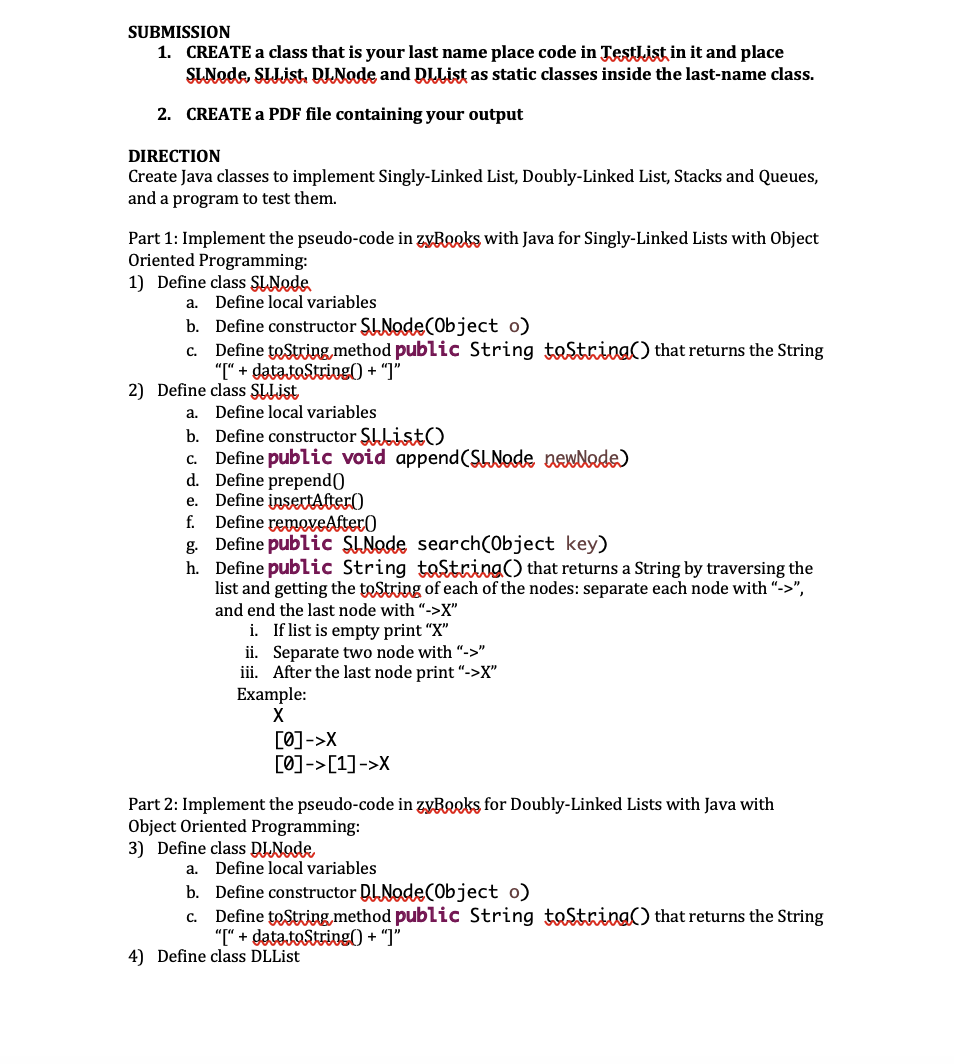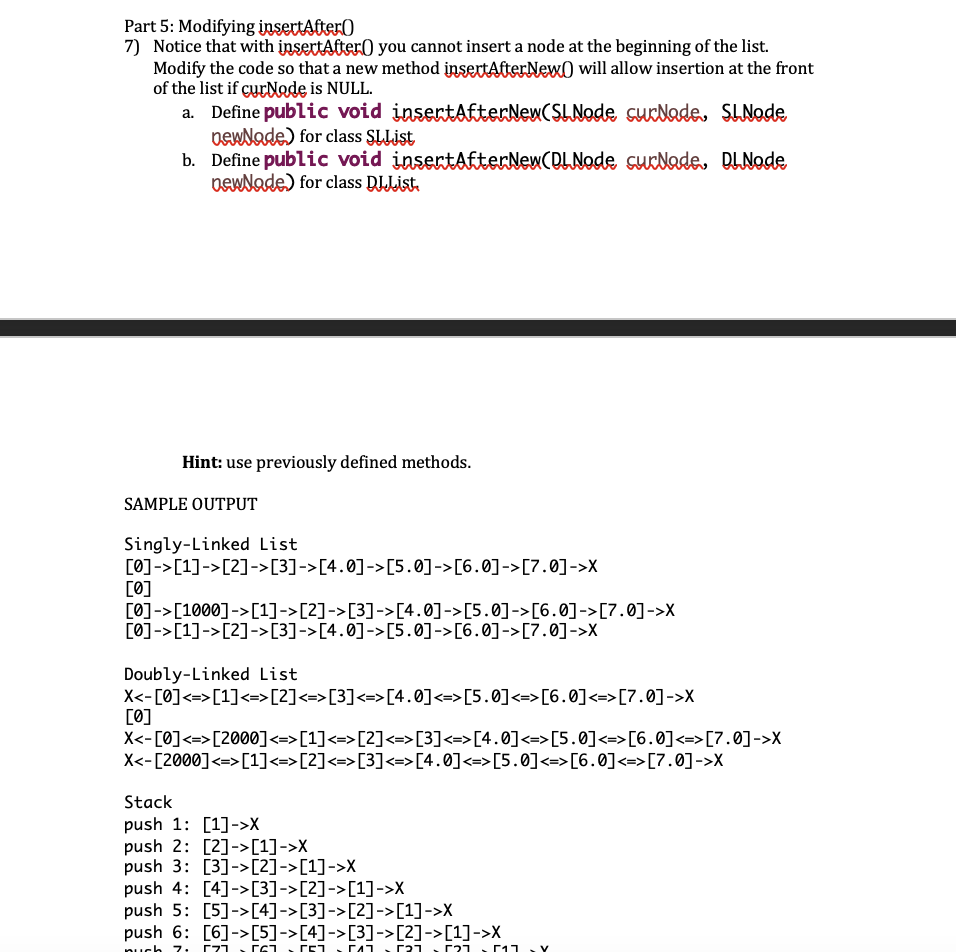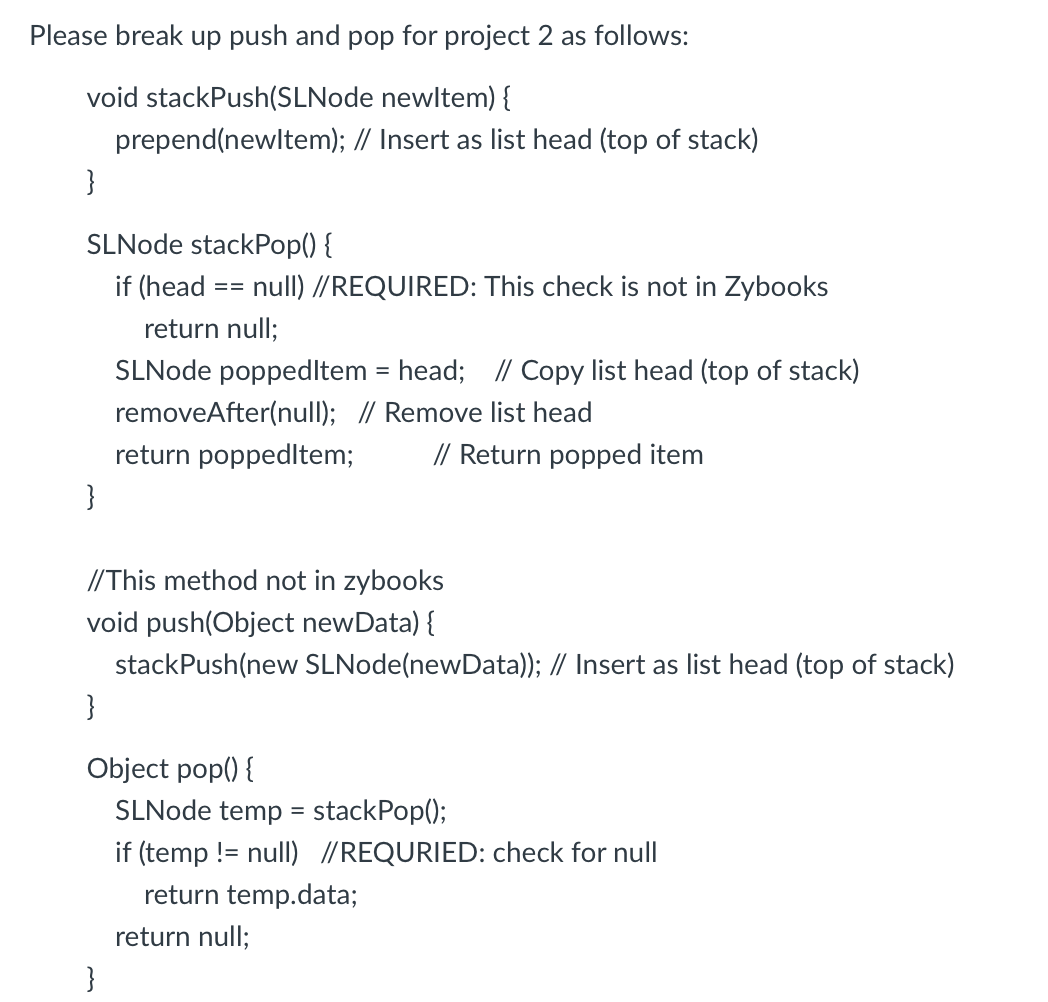Question
Part 4: Test your code: Use the following code to test your results. Copy the output and turn in as PDF. public class TestList {

Part 4: Test your code:
- Use the following code to test your results. Copy the output and turn in as PDF.
public class TestList {
static final int N = 4;
public static void main(String[] args) {
testSLList();
testDLList();
testStackQueue();
}
static void testSLList() {
System.out.println("Singly-Linked List");
SLList list1 = new SLList();
for (int i = 0; i N; i++)
list1.append(new SLNode(i));
for (double d = N; d N; d++)
list1.append(new SLNode(d));
System.out.println(list1);
SLNode temp = list1.search(0);
System.out.println(temp);
list1.insertAfter(temp, new SLNode(1000));
System.out.println(list1);
list1.removeAfter(temp);
System.out.println(list1);
System.out.println();
}
static void testDLList() {
System.out.println("Doubly-Linked List");
DLList list2 = new DLList();
for (int i = 0; i N; i++)
list2.append(new DLNode(i));
for (double d = N; d N; d++)
list2.append(new DLNode(d));
System.out.println(list2);
DLNode temp = list2.search(0);
System.out.println(temp);
list2.insertAfter(temp, new DLNode(2000));
System.out.println(list2);
list2.remove(temp);
System.out.println(list2);
System.out.println();
}
public static void testStackQueue() {
System.out.println("Stack");
SLList stack1 = new SLList();
final int M = 10;
for (int i = 1; i
System.out.print("push " + i + ": ");
stack1.push(i);
System.out.println(stack1);
}
for (int i = 1; i
System.out.print(stack1.pop() + " pop: ");
System.out.println(stack1);
}
System.out.println();
System.out.println("Quene");
SLList queue1 = new SLList();
for (int i = 1; i
System.out.print("enqueue " + i + ": ");
queue1.enqueue(i);
System.out.println(queue1);
}
for (int i = 1; i
System.out.print(queue1.dequeue() + " dequeue: ");
System.out.println(queue1);}
System.out.println();


 \\\
\\\
Please break up push and pop for project 2 as follows:
void stackPush(SLNode newItem) { prepend(newItem); // Insert as list head (top of stack) }
SLNode stackPop() { if (head == null) //REQUIRED: This check is not in Zybooks return null; SLNode poppedItem = head; // Copy list head (top of stack) removeAfter(null); // Remove list head return poppedItem; // Return popped item } //This method not in zybooks void push(Object newData) { stackPush(new SLNode(newData)); // Insert as list head (top of stack) }
Object pop() { SLNode temp = stackPop(); if (temp != null) //REQURIED: check for null return temp.data; return null; }
SUBMISSION 1. CREATE a class that is your last name place code in Testlist in it and place SLNode, SLList, DLNode and DLlist as static classes inside the last-name class. 2. CREATE a PDF file containing your output DIRECTION Create Java classes to implement Singly-Linked List, Doubly-Linked List, Stacks and Queues, and a program to test them. Part 1: Implement the pseudo-code in zyBooks with Java for Singly-Linked Lists with Object Oriented Programming: 1) Define class SL Node. a. Define local variables b. Define constructor SL Node(Object o) c. Define toString method public String tastring(that returns the String "[" + data.toString() + "]" 2) Define class SlList a. Define local variables b. Define constructor Slloisto c. Define public void append(SL. Node newlade) d. Define prependo e. Define insertAfter f. Define removeAfter0 g. Define public SL Node search(Object key) h. Define public String tastring that returns a String by traversing the list and getting the toString of each of the nodes: separate each node with "->", and end the last node with "->X" i. If list is empty print "X" ii. Separate two node with "->" ii. After the last node print"->" Example: X [0]->X [0]->[1]->X Part 2: Implement the pseudo-code in zyBooks for Doubly-Linked Lists with Java with Object Oriented Programming: 3) Define class DI.Node a. Define local variables b. Define constructor DL. Node(Object o) c. Define toString method public String tastring() that returns the String "L" + data.toString() + "]" 4) Define class DLList a. Define local variables b. Define constructor DlListo) Define public void appendCDL Node newdade) d. Define prependo e. Define insertAfter0 f. Define remove() - fix the code so it will not crash if no elements g. Define public DL Node search(Object key) h. Define public String tastring() that returns a String by traversing the list and getting the toString of each of the nodes: i. If list is empty print "X" ii. Before the first node print X" iv. After the last node print"->" Example: X XX X[0]->X X[0][1] ->X i. Define public String reverseString() that returns a String similar to toString but traverses in reverse. Part 3: Implement the pseudo-code in zyBooks for Stacks and Queues with Java with Object Oriented Programming within the SLlist class 5) Add the following to the SLlist class Define void stackRush (SL Node bewItem b. Define SL Node stackPon() c. Define queuePusho d. Define queuePop Normally, we just want to push and pop Objects directly, and not SL Nedes. Create the following: e. Define void push(Object newdata) f. Define Object pop() g. Define enqueue 0 h. Define dequeue Part 5: Modifying insertAfter 7) Notice that with insertAfter you cannot insert a node at the beginning of the list. Modify the code so that a new method insertAfterNew will allow insertion at the front of the list if curNode is NULL. a. Define public void insertAfterNewCSL Node surdada, SLNode Dewlade) for class SlList b. Define public void insertAfterNewCDL Node surdade, DLNode Dewlade) for class Dilist Hint: use previously defined methods. SAMPLE OUTPUT Singly-Linked List [0]->[1]->[2]->[3]->[4.0]->[5.0]->[6.0]->[7.0]->X [0] [0]->[1000]->[1]->[2]->[3]->[4.0]->[5.0]->[6.0]->[7.0] ->X [0]->[1]->[2]->[3]->[4.0]->[5.0]->[6.0]->[7.0]->X Doubly-Linked List X[1][2][3][4.0][5.0][6.0][7.0]->X [0] X[2000][1][2][3][4.0][5.0][6.0][7.0]->X X[1][2][3][4.0][5.0][6.0][7.0] ->X Stack push 1: [1]->X push 2: [2]->[1]->X push 3: [3]->[2]->[1]->X push 4: [4]->[3]->[2]->[1]->X push 5: [5] ->[4]->[3] ->[2]->[1]->X push 6: [6]->[5] ->[4]->[3]->[2]->[1]->X nuch 7. T r r Tr TA TE TE Please break up push and pop for project 2 as follows: void stackPush(SLNode newltem) { prepend(newltem); // Insert as list head (top of stack) } SLNode stackPop() { if (head null) //REQUIRED: This check is not in Zybooks return null; SLNode poppedltem = head; // Copy list head (top of stack) removeAfter(null); // Remove list head return poppedltem; // Return popped item } //This method not in zybooks void push(Object newData) { stackPush(new SLNode(newData)); // Insert as list head (top of stack) } Object pop() { SLNode temp = stackPop(); if (temp != null) //REQURIED: check for null return temp.data; return null; } Singly-Linked List [0]->[1]->[2]->[3]->[4.0]->[5.0]->[6.0]->[7.0]->X [0] [0]->[1000]->[1]->[2]->[3]->[4.0]->[5.0]->[6.0]->[7.0]->X [0]->[1]->[2]->[3]->[4.0]->[5.0]->[6.0]->[7.0]->X Doubly-Linked List X[1][2][3][4.0][5.0][6.0][7.0]->X [0] X[2000][1][2][3][4.0][5.0][6.0][7.0]->X X[1][2][3][4.0][5.0][6.0][7.0]->X Stack push 1: [1]->X push 2: [2] ->[1]->X push 3: [3]->[2]->[1]->X push 4: [4]->[3]->[2] ->[1]->X push 5: [5]->[4]->[3] ->[2] ->[1]->X push 6: [6] ->[5]->[4] ->[3]->[2]->[1]->X push 7: [7]->[6]->[5] ->[4]->[3]->[2]->[1]->X push 8: [8]->[7]->[6] ->[5] ->[4]->[3]->[2]->[1]->X push 9: [9]->[8]->[7]->[6] ->[5]->[4]->[3]->[2]->[1]->X 9 pop: [8]->[7]->[6] ->[5]->[4]->[3]->[2]->[1]->X 8 pop: [7]->[6] ->[5] ->[4]->[3]->[2] ->[1]->X 7 pop: [6] ->[5] ->[4]->[3]->[2]->[1]->X 6 pop: [5] ->[4]->[3]->[2] ->[1]->X 5 pop: [4]->[3]->[2]->[1]->X 4 pop: [3]->[2] ->[1]->X 3 pop: [2]->[1]->X 2 pop: [1]->X 1 pop: X Quene enqueue 1: [1]->X enqueue 2: [1]->[2]->X enqueue 3: [1]->[2]->[3]->X enqueue 4: [1]->[2]->[3] ->[4]->X enqueue 5: [1]->[2]->[3]->[4]->[5] ->X enqueue 6: [1]->[2]->[3]->[4]->[5] ->[6] ->X enqueue 7: [1]->[2] -> [3]->[4]->[5] ->[6] -> [7]->X enqueue 8: [1]->[2]->[3]->[4] ->[5]->[6] ->[7]->[8]->X enqueue 9: [1]->[2]->[3]->[4]->[5] ->[6] ->[7]->[8]->[9]->X 1 dequeue: [2]->[3]->[4]->[5]->[6] ->[7]->[8] ->[9]->X SUBMISSION 1. CREATE a class that is your last name place code in Testlist in it and place SLNode, SLList, DLNode and DLlist as static classes inside the last-name class. 2. CREATE a PDF file containing your output DIRECTION Create Java classes to implement Singly-Linked List, Doubly-Linked List, Stacks and Queues, and a program to test them. Part 1: Implement the pseudo-code in zyBooks with Java for Singly-Linked Lists with Object Oriented Programming: 1) Define class SL Node. a. Define local variables b. Define constructor SL Node(Object o) c. Define toString method public String tastring(that returns the String "[" + data.toString() + "]" 2) Define class SlList a. Define local variables b. Define constructor Slloisto c. Define public void append(SL. Node newlade) d. Define prependo e. Define insertAfter f. Define removeAfter0 g. Define public SL Node search(Object key) h. Define public String tastring that returns a String by traversing the list and getting the toString of each of the nodes: separate each node with "->", and end the last node with "->X" i. If list is empty print "X" ii. Separate two node with "->" ii. After the last node print"->" Example: X [0]->X [0]->[1]->X Part 2: Implement the pseudo-code in zyBooks for Doubly-Linked Lists with Java with Object Oriented Programming: 3) Define class DI.Node a. Define local variables b. Define constructor DL. Node(Object o) c. Define toString method public String tastring() that returns the String "L" + data.toString() + "]" 4) Define class DLList a. Define local variables b. Define constructor DlListo) Define public void appendCDL Node newdade) d. Define prependo e. Define insertAfter0 f. Define remove() - fix the code so it will not crash if no elements g. Define public DL Node search(Object key) h. Define public String tastring() that returns a String by traversing the list and getting the toString of each of the nodes: i. If list is empty print "X" ii. Before the first node print X" iv. After the last node print"->" Example: X XX X[0]->X X[0][1] ->X i. Define public String reverseString() that returns a String similar to toString but traverses in reverse. Part 3: Implement the pseudo-code in zyBooks for Stacks and Queues with Java with Object Oriented Programming within the SLlist class 5) Add the following to the SLlist class Define void stackRush (SL Node bewItem b. Define SL Node stackPon() c. Define queuePusho d. Define queuePop Normally, we just want to push and pop Objects directly, and not SL Nedes. Create the following: e. Define void push(Object newdata) f. Define Object pop() g. Define enqueue 0 h. Define dequeue Part 5: Modifying insertAfter 7) Notice that with insertAfter you cannot insert a node at the beginning of the list. Modify the code so that a new method insertAfterNew will allow insertion at the front of the list if curNode is NULL. a. Define public void insertAfterNewCSL Node surdada, SLNode Dewlade) for class SlList b. Define public void insertAfterNewCDL Node surdade, DLNode Dewlade) for class Dilist Hint: use previously defined methods. SAMPLE OUTPUT Singly-Linked List [0]->[1]->[2]->[3]->[4.0]->[5.0]->[6.0]->[7.0]->X [0] [0]->[1000]->[1]->[2]->[3]->[4.0]->[5.0]->[6.0]->[7.0] ->X [0]->[1]->[2]->[3]->[4.0]->[5.0]->[6.0]->[7.0]->X Doubly-Linked List X[1][2][3][4.0][5.0][6.0][7.0]->X [0] X[2000][1][2][3][4.0][5.0][6.0][7.0]->X X[1][2][3][4.0][5.0][6.0][7.0] ->X Stack push 1: [1]->X push 2: [2]->[1]->X push 3: [3]->[2]->[1]->X push 4: [4]->[3]->[2]->[1]->X push 5: [5] ->[4]->[3] ->[2]->[1]->X push 6: [6]->[5] ->[4]->[3]->[2]->[1]->X nuch 7. T r r Tr TA TE TE Please break up push and pop for project 2 as follows: void stackPush(SLNode newltem) { prepend(newltem); // Insert as list head (top of stack) } SLNode stackPop() { if (head null) //REQUIRED: This check is not in Zybooks return null; SLNode poppedltem = head; // Copy list head (top of stack) removeAfter(null); // Remove list head return poppedltem; // Return popped item } //This method not in zybooks void push(Object newData) { stackPush(new SLNode(newData)); // Insert as list head (top of stack) } Object pop() { SLNode temp = stackPop(); if (temp != null) //REQURIED: check for null return temp.data; return null; } Singly-Linked List [0]->[1]->[2]->[3]->[4.0]->[5.0]->[6.0]->[7.0]->X [0] [0]->[1000]->[1]->[2]->[3]->[4.0]->[5.0]->[6.0]->[7.0]->X [0]->[1]->[2]->[3]->[4.0]->[5.0]->[6.0]->[7.0]->X Doubly-Linked List X[1][2][3][4.0][5.0][6.0][7.0]->X [0] X[2000][1][2][3][4.0][5.0][6.0][7.0]->X X[1][2][3][4.0][5.0][6.0][7.0]->X Stack push 1: [1]->X push 2: [2] ->[1]->X push 3: [3]->[2]->[1]->X push 4: [4]->[3]->[2] ->[1]->X push 5: [5]->[4]->[3] ->[2] ->[1]->X push 6: [6] ->[5]->[4] ->[3]->[2]->[1]->X push 7: [7]->[6]->[5] ->[4]->[3]->[2]->[1]->X push 8: [8]->[7]->[6] ->[5] ->[4]->[3]->[2]->[1]->X push 9: [9]->[8]->[7]->[6] ->[5]->[4]->[3]->[2]->[1]->X 9 pop: [8]->[7]->[6] ->[5]->[4]->[3]->[2]->[1]->X 8 pop: [7]->[6] ->[5] ->[4]->[3]->[2] ->[1]->X 7 pop: [6] ->[5] ->[4]->[3]->[2]->[1]->X 6 pop: [5] ->[4]->[3]->[2] ->[1]->X 5 pop: [4]->[3]->[2]->[1]->X 4 pop: [3]->[2] ->[1]->X 3 pop: [2]->[1]->X 2 pop: [1]->X 1 pop: X Quene enqueue 1: [1]->X enqueue 2: [1]->[2]->X enqueue 3: [1]->[2]->[3]->X enqueue 4: [1]->[2]->[3] ->[4]->X enqueue 5: [1]->[2]->[3]->[4]->[5] ->X enqueue 6: [1]->[2]->[3]->[4]->[5] ->[6] ->X enqueue 7: [1]->[2] -> [3]->[4]->[5] ->[6] -> [7]->X enqueue 8: [1]->[2]->[3]->[4] ->[5]->[6] ->[7]->[8]->X enqueue 9: [1]->[2]->[3]->[4]->[5] ->[6] ->[7]->[8]->[9]->X 1 dequeue: [2]->[3]->[4]->[5]->[6] ->[7]->[8] ->[9]->XStep by Step Solution
There are 3 Steps involved in it
Step: 1

Get Instant Access to Expert-Tailored Solutions
See step-by-step solutions with expert insights and AI powered tools for academic success
Step: 2

Step: 3

Ace Your Homework with AI
Get the answers you need in no time with our AI-driven, step-by-step assistance
Get Started


